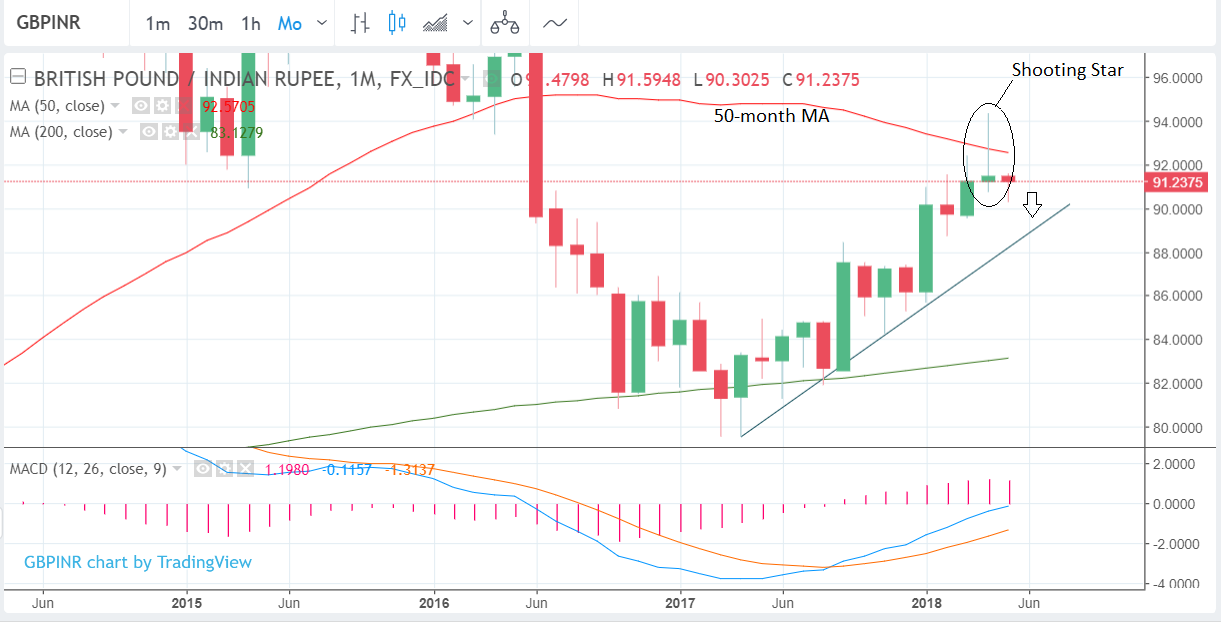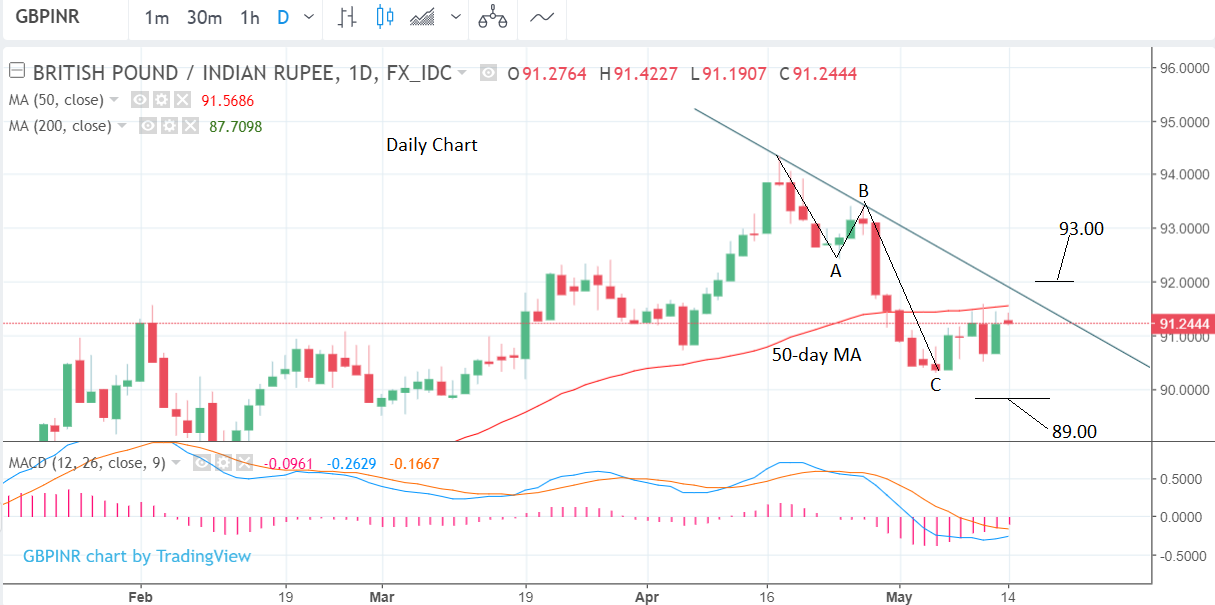Pound-to-Rupee Rate's Forecast for the Week Ahead
- GBP/INR still oscillating between 90-91
- Labour market data out on Tuesday will be key for Sterling
- Rupee's main release is inflation data out on Monday afternoon

© Adobe Stock
Not much change from the previous week - one Pound buys 91.24 Rupees on the interbank market at the time of writing - about a Rupee more than the previous week when the exchange rate opened at 90.34.
Whilst the Pound weakened after the Bank of England delayed their planned interest rate hike on Thursday, the Rupee - which is sensitive to the price of oil because it has to import all its fuel - faced headwinds from geopolitical tensions which pushed up the price of oil.
From a technical perspective, GBP/INR continues to present a fairly bearish picture: despite the medium-term uptrend.
The pair has formed a bearish shooting star candlestick pattern on the monthly chart in April, which is a negative sign.
The pattern gains confirmation if the following month is also bearish, which, so far, May has been; and whilst we are far from the end of the month it's not a good early sign.
The location of the 50-month moving average (MA) intersecting the April highs at 92.57 suggests the MA is acting like a ceiling and preventing upside - a further bearish sign.
Very often large MAs act as an impediment to further upside. Normally there is increased trading activity around them owing to their popularity amongst investors.
The daily chart below suggests a more balanced outlook.
The pair has pulled back after peaking at 94.34 on April 17, and it has so far penetrated further and more deeply than we previously imagined likely.
The pair has now broken below a key support zone composed of the 50-day MA and the 2015 lows situated in the 91 area of the chart.
GBP/INR has also formed a three-wave ABC pattern during its pull-back. ABC's are only ever corrective and suggest the uptrend will resume after they have completed.
The ABC on GBP/INR is probably now complete as wave C is now of an equal length or longer than A which is a minimum requirement for completion.
Indeed, the exchange rate has now recovered by a Rupee and risen back up to the 50-day MA. There is now the possibility it could recover and break above the 50-day, but until we see a move above 92.00 we remain neutral. If id does break above 92.00, however, we would expect a move up to a target at 93.00.
Equally, a break lower would also be a bearish indicator.
The ABC may fail and the exchange rate could start a new trend down.
The 90 level is an obstacle as it is a key psychological level which may offer more support than usual as it could be the locus for increased buying and selling.
In order to confirm more downside, therefore, we would ideally wish to see a clear break below 89.75, with an initial downside target at 89.00.
INR: What to Watch
The main release for the Rupee is inflation data out on Monday (today), May 14 at 13.00 GMT.
The consensus expectation is for a 4.42% rise to register in April from 4.28% previously.
Inflation is significant for currencies because it impacts on interest rates and these are correlated with currency strength because foreign investors tend to prefer to move their money to jurisdictions where they can earn the most interest.
Inflation has fallen from a peak of 5.21% at the end of 2017 and the lower it goes the greater the risk the Reserve Bank of India (RBI) have to cut interest rates, which would be negative for the Rupee.
Assuming inflation pops higher in April, however, in line with expectations, the Rupee will probably hold its value as it will lessen the chances of the RBI cutting rates.
Another reason the RBI will probably not lower interest rates is that they will want to defend the Rupee so as to maintain its buying power, at least according to Richard Kelly, head of research at investment bank TD Securities in Toronto.
The RBI will want the Rupee to be strong because the price of oil has risen significantly over the last week and India has to import most of its oil from overseas, so a strong Rupee can more easily afford the increasingly expensive cost of oil.
The rising cost of oil is also a bearish factor on INR as it increases aggregate demand for outside currencies required to purchase and import the oil.
GBP: What to Watch
Data is back to the forefront for Pound Sterling now that markets are trading the currency on expectations for future interest rate moves at the Bank of England. Indeed, we saw Sterling come under pressure on Thursday, May 10 after the Bank chose not to raise interest rates at their May policy event.
What we do know is that the Bank will only deliver a Sterling-supportive interest rate rise should UK data show signs of a strong recovery from a soft start to the year, and this week's data releases will, therefore, be key.
Tuesday, May 15
Foreign exchange markets will be eyeing labour market statistics for March and April at 09:30 AM B.S.T.
The claimant count for April is forecast to have risen to 7.5K from 11.6K previously, while the unemployment rate is forecast to stay unchanged at 4.2% in March.
The three-month-on-three-month change in employment will be key, but we are yet to see market forecasts for the outcome.
Analysts at Lloyds Bank Commercial Banking are looking for a rise in employment of 150K, saying "the employment gain for the three months to March will provide a measure of the underlying strength of the economy." A rise if 150K "would be a substantive increase for the quarter, consistent with the view that the slowdown in output was most likely temporary."
For Sterling the most important release of the day is, however, likely to be the wage data - the average earnings index + bonus for March is forecast to have registered growth of 2.6%, down from the previous month's 2.8%.
Should wages beat expectations we would expect Sterling to rally as it suggests there is a real risk of domestically-generated inflationary pressures rising in coming months. Such an observation would likely steer the Bank of England's hand towards delivering an interest rate rise in August.

At 10:00 AM Mark Carney and some of his lieutenants will be under the spotlight when they are questioned by the Treasury Select Committee in Westminster on their current guidance for interest rates and expectations for the UK economy.
Expect some criticism from MPs on the apparent U-turn performed by the Bank of England when they opted to not raise rates in May, despite having dropped some significant hints that such an outcome was likely over preceding months.
The Bank will no doubt point at the data. What could move markets is any strong hint on future rate prospects for the economy, so keep an eye on the newswires.
"The market now assigns a greater-than-even chance that the MPC will be on hold for the rest of the year. We are not so sure, because we look for GDP growth to rebound in coming quarters. We acknowledge the downside risks that
Brexit uncertainty imparts to the economic outlook, but we still forecast that the MPC will raise rates 25 bps at the August 2 policy meeting. After that rate hike, we then look for the MPC to remain on hold through the end of the year," say analysts at global investment bank Wells Fargo in their latest assessment on the future of UK interest rates.
Get up to 5% more foreign exchange by using a specialist provider to get closer to the real market rate and avoid the gaping spreads charged by your bank when providing currency. Learn more here.


